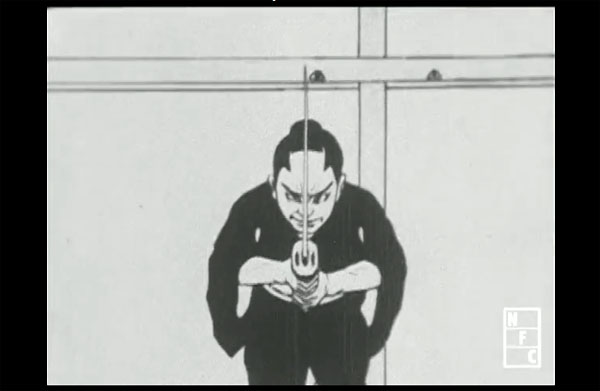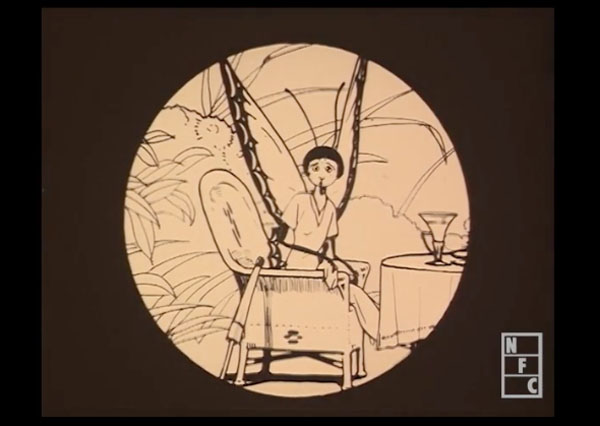
Yusuji Murata
Murata was always an artist. As withthe majority of early Japanese animators, he began by working in another film connected job, signboard painting, after he graduated from junior high. He studied animation techniques under pioneer Sanae Yamomoto (subject of an earlier article here), soon going off on his own, at first as an assistant for Seitaro Kitayama. But that studio was destroyed in 1923’s Kanto earthquake.
In 1925, the producer Yokohama Cinema Shokai put Murata in charge of the animation of the Athena Library Series, which consisted of folklore and fairy tale adaptations,“edutainment” and lightweight animal frivolities. The distribution was largely to schools and home libraries, sometimes free of charge to cultivate the national spirit as the nation’s war faring escalated. The stories were by Chuzo Aochi, credited as “supervisor”. The team created a few NORAKURO (“Black Stray”) shorts, adapted from the popular comic strip. Murata’s stint on the Athena Library Series was long lived; approximately 50 films had been made by the time he left the post in 1937.
Thus established as an animation master, Murata went on to work for other studios as a supervisor and writer. He directed his last film in 1947. During this time he also established a number of his own companies, handling mainly ads, advertisements, and sequences for live action features (he animated the introduction for a live action MIGHTY ATOM (“Astro Boy”) TV series made in 1959-60, two years before the animated incarnation).
Murata is a rare animator that followed Winsor McCay’s lead: As opposed to the slapstick stylings of Murata’s teacher Sanae Yamamoto, Murata conveyed his fantastic tales in a rather droll, dry manner. Even his beasts are anatomically logical, and when they fleetingly squash, stretch or flatten, the results are sometimes discomfiting and always bizarre. A fine array of his range and methods can be seen in this compilation of clips assembled by “m Uga”.
THE MONKEY SWORD MASAMUNE (1930)
A retelling of a folklore extolling mindful heroism. The animation is sparing, but manages to make for a majestic work. Often, it feels more inspired by live theater or film than by standard cartoon storytelling. Eloquent poses and expressions. Note the artist’s tendency to frame scenes in circles and squares. One can detect the use of cutouts, but it is skillful and graceful. (English closed captioning is offered and recommended.)
TONPEI AND SARUKICHI (1932)
One perpetual motif of Japan’s animated scenarios, industry vs. indolence, unexpectedly gives way to a second, war preparedness. Though with caricatured animals and incorporating incongruous modern technology, this is fairly free of cartoon fun and even the Lion King is decimated by the bullied but brave hero and his allies (likely representing a “victimized” Japan or Manchuria) .

RASCAL RACCOON (1933)
Monks are heckled by a merry but hungry tanuki that steals their sacrifices to the Buddha. This zestful little comedy is framed by a kamishibai, a street entertainer who’d narrate stories illustrated on specially painted boards revealed in succession. In the 1950s, early television sets would be referred to as “electric kamishibai” and pushed the live storytellers out of their business. Many kamishibai illustrators moved on to manga.

TWO WORLDS (1929)
Two worlds; humanized amphibians and insects indulging in Western decadence come to floridly grim endings, while the humble ant family thrives from the wise thrift of their traditional Japanese lifestyle.
Murata’s first film for the Ministry of Education, and reviewed by the Emperor. The film is presented in its original tinted colors.

NOTE: We’ve linked to Murata cartoons in earlier posts. Click these film titles to view those posts: THE STOLEN LUMP (1929) and WHY THE SEA WATER IS SALTY (1935).
Please visit Milton Knight’s website and explore his artwork (many of his paintings are for sale), his comics and inquire about commissions.
He has a Patreon campaign where you can learn about his work in animation (Cool World, Sonic The Hedgehog, etc) and support his many projects.
To get a sample of his personal style – as well as his versatility – check the video below:


 Milton Knight is an artist of wide experience, having been involved in comics, illustration, animation and painting. You’ve seen his animation in Sonic The Hedgehog, The Twisted Tales of Felix The Cat and in Ralph Bakshi’s Cool World. His comic art has graced Mighty Mouse, Teenage Mutant Ninja Turtles and his own book, Hugo. Knight has also recently completed his first novel. Visit his blog at
Milton Knight is an artist of wide experience, having been involved in comics, illustration, animation and painting. You’ve seen his animation in Sonic The Hedgehog, The Twisted Tales of Felix The Cat and in Ralph Bakshi’s Cool World. His comic art has graced Mighty Mouse, Teenage Mutant Ninja Turtles and his own book, Hugo. Knight has also recently completed his first novel. Visit his blog at 











































These are some incredible films, all new to me. While there are definitely slapstick elements present in the tanuki’s hijinks at the Buddhist temple, Murata’s superb draftsmanship really does recall that of McCay, especially in “Futatsu no Sekai” (two worlds). I’ll have to examine more of his work. And a live-action Tetsuwan Atomu prior to Tezuka? Sugoi!
The cinematic equivalent to the kamishibai was the benshi, a storyteller who provided narration for Japanese silent films, sometimes (but not always) with musical accompaniment as well. They were so popular that silent films continued to be produced in Japan throughout the 1930s, although sound films were also made from the beginning of that decade, All of these cartoons would have been narrated by benshi when they were first released. Benshi also had to provide voices for every character in the films they narrated and were therefore a precursor to seiyuu, or anime voice actors.
Oshiete kurete arigatou gozaimasu, Knight-sensei.
ありがとう、先生 ! ! !
(Thanks, teacher ! ! !)
Many thanks for an enjoyable evening watching these animated selections.
It would appear that anime is a postwar phenomenon.
Depends how you define it. If you mean the specific style developed by Tezuka and others for the television market, then yes, you’re right. However, in Japanese “anime” just means animation of any kind, including Western, and in English the word may refer to any Japanese animation regardless of style or vintage. For clarity’s sake, it’s probably best to refer to the work of Murata and his contemporaries as “early anime”.
Man. This is great stuff. His art style is very similar to Osamu Tezuka.
Fascinating stuff! This is the kind of article Cartoon Research should publish more of
Description
Tako No Hone – Yasuji Murata
Background Info:
This early, Japanese animation was created by creating ‘cut outs.’ These were individually cut figures that were drawn and cut to represent successive movements. They were then photographed sequentially, against a contrasting background (stop-motion). When projected at a given speed, they become animated. This film, from 1927, is one of the earliest animated sequences (possibly the second ever to be created). It is called, ‘Tako No Hone,’ (The Octopus’s Bone’) but should be understood as, ‘How the Octopus lost its Skeleton.’ It was created by Yasuji Murata (村田安司) (1896 – 1966), The story is based on the traditional, Japanese myth of Urashima Taro, in which a fisherman is transported from the seashore to a fantastic underwater world, riding on a giant turtle. It is part of a larger myth, Why the Sea is Salty.’
Production Info:
‘Tako No Hone was released theatrically on November 2, 1927, at.Yokohama Cinema, probably in 35 km, Shokai Theatrical Cartoon
Directed By Yasuji Murata.
Produced By Yasuji Murata.
Written By Chuzo Aoji.
Story: Chuzo Aoji,
Cinematography: Yukikiyo Ueno
Restoration:
In 2017, I found a single 9.5 mm reel at an online, Japanese auction. This format was made by the French company Pathe’ and not used in the USA. It was a second generation, copied from the 35mm, around the time of its release. It was in poor condition, with many broken edits, splices, and scratches in the emulsion, all coated in a thick layer of grime. It was taken to Movette Film Transfer in San Francisco and physically restored, run on an antique 9.5 mm projector and then digitized. It was then, further digitally cleaned and transferred to 1080p24, speed corrected, 1556 Overscan, with post-scan, image stabilization. Later, I had the Inter titles translated into English and added to the film. You may need to pause it to read them because they go by fast. This and further information can be found in the pull down information section below the active window.
Since 1927 it had not been re-exibited, made commercially, or publicly available, except for one exhibit, in 1976, at the Museum of Modern Art, in NYC, Two copies of unknown format are in Japanese film archives.
The film’s copyrights have expired and the film is in the public domain.
This film is one of the earliest animated sequences (possibly the second ever to be created). It is called, ‘Tako No Hone,’ (The Octopus’s Bone’) but should be understood as, ‘How the Octopus lost its Skeleton.’ It was created by Yasuji Murata (村田安司) (1896 – 1966), The story is based on the traditional, Japanese myth of Urashima Taro, in which a fisherman is transported from the seashore to a fantastic underwater world, riding on a giant turtle. It is part of a larger myth, Why the Sea is Salty.’